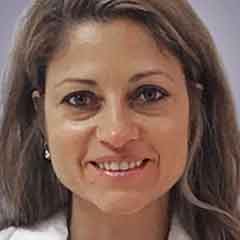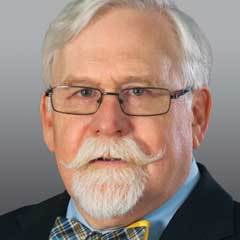




Hide/Show
11:00 a.m.–11:30 a.m. Central | Track: General | CRCE: 0.00
11:30 a.m.–12:00 p.m. Central | Track: General | CRCE: 0.00
Show description
The AARC, ARCF, and NBRC will recognize their best and brightest during this year’s virtual awards ceremony. Several AARC members were recognized for their achievements. This year the ceremony will be broken up into 3 parts and presented on the virtual platform. You will have the chance to rewatch the ceremony in its entirety with friends, family, and colleagues on the AARC Facebook and YouTube.
12:05 p.m.–12:55 p.m. Central | Track: Adult Acute Care | CRCE: 0.83
Richard Kallet, MS, RRT, FAARC
Show description

Since the early descriptions of ARDS in the late 1960s, how to provide mechanical ventilation for patients with ARDS has been hotly contested. In the early days, IMV vs. Assist control and low vs high PEEP were sources of intense disagreement. A plethora of high frequency ventilation devices have come and gone. The landmark work regarding ventilator induced lung injury in the early 2000s changed how we approach ventilatory support in ARDS. ECMO has danced on the edges of ARDS management for 50 years. What is the future of mechanical ventilation in ARDS? Avoiding invasive ventilation through NIV, HFNC and ECMO are on the rise. Will driving pressure measurement and control open a new era? What about electronic muscle stimulation and diaphragm protective ventilation? This lecture asks, Quo Vadis, literally, General, where are we going?
1:00 p.m.–1:35 p.m. Central | Track: Adult Acute Care
1:00 p.m.–1:35 p.m. Central | CRCE: 0.58
Sarah Varekojis, PhD, RRT, FAARC
Show description

Respiratory care education is continually evolving to meet the demands and expectations of patient care, accreditation, credentialing, and higher education. Health professions education has transformed from discipline-specific training to now incorporating interprofessional education. The premise is that health professions students should learn together since they will be working together. And along those lines, interprofessional collaboration for continuing competency training is being used by many health care facilities to ensure communication and teamwork are prioritized to ensure patient safety and decreased costs of care. The presentation will review the evolution of interprofessional education in respiratory care and discuss future directions.
1:40 p.m.–2:15 p.m. Central | CRCE: 0.58
Rachel Culbreth, PhD, MPH, RRT
Show description

While COVID-19 has dominated headlines, concerns related to vaping and lung injury continue. Smoking rates and use of vaping appear to be increased in younger populations, particularly women. Hookah lounges have proliferated on college campuses and have become part of the tobacco abuse spectrum. This review will evaluate the epidemiology of new smoking alternatives, vaping injuries, and other forms of smoking on public health.
1:00 p.m.–1:35 p.m. Central | Track: Diagnostics | CRCE: 0.58
Ellen Becker, PhD, RRT, FAARC
Show description

Last year there were increased calls to rethink the use of race-based algorithms in medical care. How does this affect our use of race in reference equations for pulmonary function testing? This lecture reviews the basics behind pulmonary function reference values with emphasis on the recent literature that critiques the use of race-based algorithms.
1:00 p.m.–1:35 p.m. Central | Track: Neonatal/Pediatric | CRCE: 0.58
John Emberger, RRT, RRT-ACCS, FAARC
This session sponsored by:
Show description

High frequency jet and oscillatory ventilation have been around for more than 30 years. Participants will gain a knowledge of the current indications and management strategies based on the newest evidence in the literature for using high frequency ventilation in the neonatal ICU. Several cases will be presented that underscore the optimal use of high frequency ventilation for neonates.
1:00 p.m.–2:30 p.m. Central | Track: Clinical Practice | CRCE: 1.50
Supported by an unrestricted educational grant from
Show description
Researchers present the results of their work. Authors briefly present their findings and engage in an open discussion with the attendees.
1:40 p.m.–2:15 p.m. Central | Track: Neonatal/Pediatric | CRCE: 0.58
Stephen Hepditch, BS, RRT, RRT-NPS
Show description

Unplanned extubations (UE) in the NICU setting lead to serious harm to critically ill infants each year. Some of them suffer cardiovascular collapse after UE events, but many more do not require re-intubation, indicating missed opportunities for earlier ventilator liberation. This discussion will focus on “optimizing” management of mechanically ventilated neonates by addressing the balance between UE prevention and appropriate evaluation for extubation readiness.
1:40 p.m.–2:15 p.m. Central | Track: Diagnostics | CRCE: 0.58
Carl Mottram, RRT, RPFT, FAARC
Show description

The new ATS-ERS Spirometry Technical Statement includes numerous changes in the testing and evaluation process. We will review these changes and the impact on testing. The discussion will also include an overview of the new grading scheme, the history of grading schemes, and the possible implication on clinical outcomes.
2:15 p.m.–2:45 p.m. Central | Track: General | CRCE: 0.00
2:50 p.m.–3:25 p.m. Central | Track: Adult Acute Care | CRCE: 0.58
PRO: John Davies, MA, RRT, FAARC
Con: Maria Madden, MS, RRT, RRT-ACCS
Show description


In 2017, there was a spirited debate about the use of high-flow nasal cannula oxygen therapy and noninvasive ventilation for acute respiratory failure. What if anything has changed since then? Should RTs be using HFNC more, or less? Join this session to hear two experts review the available data and debate this controversy from opposing perspectives.
2:50 p.m.–3:25 p.m. Central | Track: Clinical Practice | CRCE: 0.58
Manju Parne BS, RRT, CPFT
Show description

An Interventional Pulmonology (IP) Program is an advanced subspecialty of pulmonary medicine that focuses on the diagnostic and treatment of chest diseases. Working together with thoracic surgeons, oncologists, and radiation oncologists, and interventional respiratory therapists, the IP Program treats a variety of patients in need of advanced care. Lung transplant patients require close surveillance, and the IP team partners with the INOVA Advanced Lung Disease and Transplant Program to perform various procedures including bronchoscopy and pleural fluid drainage. Interventional RTs assist in the multidisciplinary approach and personalized treatment of complex airways and pleural diseases, including lung cancer and non-malignant diseases of the chest. This integrative interventional pulmonology team offers a rare combination of exceptional outcomes for patients while employing the latest in minimally invasive techniques to treat airway obstruction, malacia, stenosis, COPD, Emphysema, and more.
2:50 p.m.–4:45 p.m. Central | Track: Neonatal/Pediatric
2:50 p.m.–3:25 p.m. Central | CRCE: 0.58
Howard Panitch, MD
Show description

Pre-term infants are increasingly being supported at the edge of viability. Despite improved survival rates, these infants commonly manifest chronic respiratory morbidity of severe bronchopulmonary dysplasia (sBPD). This lecture will review the complex pathophysiology of sBPD and characteristics of disease severity.
3:30 p.m.–4:05 p.m. Central | CRCE: 0.58
Natalie Napolitano, MPH, RRT, FAARC
This session sponsored by:
Show description

The incidence of severe bronchopulmonary dysplasia (sBPD) is increasing, and a growing number of infants require long-term invasive mechanical ventilation. This lecture will review the technical challenges associated with ventilator management in sBPD and explore evidence around novel ventilation strategies to support infants with sBPD.
4:10 p.m.–4:45 p.m. Central | CRCE: 0.58
Howard Panitch, MD
This session sponsored by:
Show description

This talk with discuss strategies for the use of NIV to assist with supporting infants with chronic lung disease (BPD, Pulmonary Hypoplasia, etc.) as a bridge to growth and as to not require an invasive airway to facilitate advanced respiratory support at home.
3:30 p.m.–4:45 p.m. Central | Track: Adult Acute Care & Education
3:30 p.m.–4:05 p.m. Central | CRCE: 0.58
Richard Branson, MSc, RRT, FAARC
Show description

The rush to share data regarding the presentation and treatment of COVID-19 pneumonia flooded journals with early observations and therapies. Was COVID-19 the same or different than ARDS? Which medications were effective, and which were supported by politicians and hopeful scientists? This talk will describe observations real and imagined, papers withdrawn from the literature due to lack of support and ideas that were published prior to sound peer review. We learned not to rush data to print and not to rush peer-review. Being correct is more important than being fast/first.
4:10 p.m.–4:45 p.m. Central | CRCE: 0.58
Dean Hess, PhD, RRT, FAARC
Show description

Respiratory Care is the official publication of the AARC and publishes research that forms the scientific basis for the profession. The online Journal provides several tools to assist in the education and training of students and therapists. These include PowerPoint files of the figures and tables, visual abstracts, the Journal podcast, and quick look summaries. The Journal provides state of the art reviews and clinical practice guidelines to detail evidence-based practice.
3:30 p.m.–4:45 p.m. Central | Track: Diagnostics
3:30 p.m.–4:05 p.m. Central | CRCE: 0.58
Matthew O’Brien, MS, RRT, RPFT
Show description

One of the most common complaints or presenting symptoms clinicians face is dyspnea. These patients come in a wide spectrum of ages with varying descriptions of their specific shortness of breath. Clinicians or advanced practice respiratory therapists need to categorize the dyspnea type and select the most appropriate pulmonary diagnostic test or evaluation. Patient centered care includes consideration of the right test at the right time.
4:10 p.m.–4:45 p.m. Central | CRCE: 0.58
Michael Morris, MD
Show description

This presentation will review case studies that highlight the evaluation and diagnosis of patients presenting with exertional dyspnea. Emphasis with be placed on the role of respiratory therapist in performing pulmonary function testing, cardiopulmonary exercise testing, chest imaging, and bronchoprovocation testing as diagnostic modalities. The attendees at this lecture will learn indications for testing and their utility in establishing a diagnosis.
3:30 p.m.–5:00 p.m. Central | Track: Clinical Practice | CRCE: 1.50
Supported by an unrestricted educational grant from
Show description
Researchers present the results of their work. Authors briefly present their findings and engage in an open discussion with the attendees.
There are no sessions that match your display preferences.